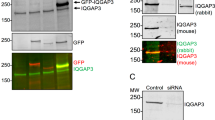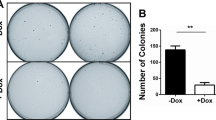Abstract
Ras proteins are small GTPases playing a pivotal role in cell proliferation and differentiation. Their activation state depends on the competing action of GTPase Activating Proteins (GAP) and Guanine nucleotide Exchange Factors (GEF). A tryptophan residue (Trp1056 in CDC25Mm-GEF), conserved in all ras-specific GEFs identified so far has been previously shown to be essential for GEF activity. Its substitution with glutamic acid results in a catalytically inactive mutant, which is able to efficiently displace wild-type GEF from p21ras and to originate a stable ras/GEF binary complex due to the reduced affinity of the nucleotide-free ras/GEF complex for the incoming nucleotide. We show here that this ‘ras-sequestering property' can be utilized to attenuate ras signal transduction pathways in mouse fibroblasts transformed by oncogenic ras. In fact over-expression of the dominant negative GEFW1056E in stable transfected cells strongly reduces intracellular rasGTP levels in k-ras transformed fibroblasts. Accordingly, the transfected fibroblasts revert to wild-type phenotype on the basis of morphology, cell cycle and anchorage independent growth. The reversion of the transformed phenotype is accompanied by DNA endoreduplication. The possible use of dominant negative ras-specific GEFs as a tool to down-regulate tumor growth is discussed.
This is a preview of subscription content, access via your institution
Access options
Subscribe to this journal
Receive 50 print issues and online access
$259.00 per year
only $5.18 per issue
Buy this article
- Purchase on Springer Link
- Instant access to full article PDF
Prices may be subject to local taxes which are calculated during checkout






Similar content being viewed by others
References
Aftab DT, Kwan J and Martin GS . 1997 Proc Natl Acad Sci USA 94: 3028–3033
Anborgh PH, Qian X, Papageorge AG, Vass WC, DeClue JE and Lowy DR . 1999 Mol Cell Biol 19: 4611–4622
Barbacid M . 1987 Annu Rev Biochem 56: 779–827
Boguski MS and McCormick F . 1993 Nature 366: 643–654
Bollag G and McCormick F . 1991 Annu Rev Cell Biol 7: 601–632
Bos JL . 1988 Mutat Res 195: 255–271
Bos JL . 1990 Cancer Res 49: 4682–4689
Brambilla R, Gnesutta N, Minichiello L, White G, Roylance AJ, Herro CE, Ramsey M, Wolfer DP, Cestari V, Rossi-Arnaud C, Grant SGN, Chapman PF, Lipp HP, Sturani E and Klein R . 1997 Nature 390: 281–286
Buday L and Downward J . 1993 Cell 73: 611–620
Campbell SL, Khosravi-Far R, Rossman KL, Clark GJ and Der CJ . 1998 Oncogene 17: 1395–1413
Chardin P, Camonis JH, Gale NW, Van Aelst L, Schlessinger J, Wigler MH and Bar-Sagi D . 1993 Science 260: 1338–1343
Chin L, Pomerantz J, Polsky D, Jacobson M, Cohen C, Cordon-Cardo C, Horner II J and DePinho RA . 1997 Genes Dev 11: 2822–2834
Chin L, Tam A, Pomerantz J, Wong M, Holash J, Bardeesy N, Shen Q, O'Hagan R, Pantginis J, Zhoul H, Horner II J, Cordon-Cardo C, Yancopoulos GD and DePinho RA . 1999 Nature 400: 468–472
Dolbeare F, Gratzner H, Pallavicini M, Gray JW . 1983 Proc Natl Acad Sci USA 80: 5573–5577
Downward J . 1997 Curr Biol 7: R258–R260
Dulic V, Stein GH, Far DF and Reed SI . 1998 Mol Cell Biol 18: 546–557
Egan SE, Giddins BW, Brooks MW, Buday L, Sizeland AM and Weinberg RA . 1993 Nature 363: 45–51
Feig LA . 1994 Curr Opin Cell Biol 6: 204–211
Giglione C and Parmeggiani A . 1998 J Biol Chem 273: 34737–34744
Guerrero C, Rojas JM, Chedid M, Esteban LM, Zimonjic DB, Popescu NC, Font de Mora J and Santos E . 1996 Oncogene 12: 1097–1107
Hahn WC, Counter CM, Lundberg AS, Beijersbergen RL, Brooks MW and Wienberg RA . 1999 Nature 400: 464–468
Kerkhoff E and Rapp UR . 1998 Oncogene 17: 1457–1462
Laemmli UK . 1970 Nature 277: 680–685
Levitzky A . 1996 Curr Opin Cell Biol 8: 239–244
Levitzky A . 1997 Medical Oncology 14: 83–89
Li N, Batzer A, Daly R, Yajnik V, Skolnik E, Chardin P, Bar-Sagi D, Margolis B and Schlessinger J . 1993 Nature 363: 85–88
Lowy DR and Willumsen BM . 1993 Annu Rev Biochem 62: 851–891
Martegani E, Vanoni M, Zippel R, Coccetti P, Brambilla R, Ferrari C, Sturani E and Alberghina L . 1992 EMBO J 11: 2151–2157
Mathiesen I . 1999 Gene Therapy 6: 508–514
Mattingly RR and Macara IG . 1996 Nature 382: 268–272
Niculescu AB III, Chen X, Smeets M, Hengst L, Prives C and Reed SI . 1998 Mol Cell Biol 18: 629–643
Park W, Mosteller RD and Broek D . 1997 Oncogene 14: 831–836
Peeper DS, Upton TM, Ladha MH, Neuman E, Zalvide J, Bernards R, DeCaprio JA and Ewen ME . 1997 Nature 386: 177–181
Plattner R, Anderson MJ, Sato KY, Fasching CL, Der CJ and Stanbridge EJ . 1996 Proc Natl Acad Sci USA 93: 6665–6670
Pulciani S, Santos E, Long LK, Sorrentino V, and Barbacid D . 1985 Mol Cell Biol 5: 2836–2841
Schweighoffer F, Faure M, Fath I, Chevalier-Multon MC, Apiou F, Dutrillaux B, Sturani E, Jacquet M and Toque B . 1993 Oncogene 8: 1477–1485
Serrano M, Lin AW, McCurrach ME, Beach D and Lowe SW . 1997 Cell 88: 593–602
Shou C, Farnsworth CL, Neel BG and Feig LA . 1992 Nature 358: 351–354
Sturani E, Abbondio A, Branduardi P, Ferrari C, Zippel R, Martegani E, Vanoni M and Denis-Donini S . 1997 Exp Cell Res 235: 117–123
Taylor SJ and Shalloway D . 1996 Current Biology 6: 1621–1627
Thomas G and Hall MN . 1997 Curr Opin Cell Biol 9: 782–787
van Biesen T, Hawes BE, Luttrell DK, Krueger KM, Touhara K, Porfiri E, Sakaue M, Luttrel LM and Lefkowitz RJ . 1995 Nature 376: 781–784
Vanoni M, Bertini R, Sacco E, Fontanella L, Rieppi M, Colombo S, Martegani E, Carrera V, Moroni A, Bizzarri C, Sabbatini V, Cattozzo M, Colagrande A and Alberghina L . 1999 J Biol Chem 274: 36656–36662
Waldman T, Zhang Y, Dillehay L, Yu J, Kinzler K, Vogelstein B and Williams J . 1997 Nature Med 3: 1034–1036
Wei W, Das B, Park W and Broek D . 1994 Gene 151: 279–284
Wei W, Schreiber SS, Baudry M, Tocco G and Broek D . 1993 Mol Brain Res 19: 339–344
Zippel R, De Maddalena C, Porro G, Modena D and Vanoni M . 1994 Int J Oncol 4: 175–179
Zippel R, Orecchia S, Sturani E and Martegani E . 1996 Oncogene 12: 2697–2703
Zohn IM, Campbell SL, Khosravi-Far R, Rossman KL and Der CJ . 1998 Oncogene 17: 1415–1438
Acknowledgements
The authors wish to thank M Pierotti for the gift of 226.4.1 cells and Fred Wittinghofer for the gift of the plasmid encoding the GST–RBD fusion. This work has been supported by grants from Dompé SpA.
Author information
Authors and Affiliations
Rights and permissions
About this article
Cite this article
Bossù, P., Vanoni, M., Wanke, V. et al. A dominant negative RAS-specific guanine nucleotide exchange factor reverses neoplastic phenotype in K-ras transformed mouse fibroblasts. Oncogene 19, 2147–2154 (2000). https://doi.org/10.1038/sj.onc.1203539
Received:
Revised:
Accepted:
Published:
Issue Date:
DOI: https://doi.org/10.1038/sj.onc.1203539
Keywords
This article is cited by
-
Oncogenic K-ras expression is associated with derangement of the cAMP/PKA pathway and forskolin-reversible alterations of mitochondrial dynamics and respiration
Oncogene (2013)
-
Glucose starvation induces cell death in K-ras-transformed cells by interfering with the hexosamine biosynthesis pathway and activating the unfolded protein response
Cell Death & Disease (2013)
-
Oncogenic K‐Ras decouples glucose and glutamine metabolism to support cancer cell growth
Molecular Systems Biology (2011)
-
Ras-dependent carbon metabolism and transformation in mouse fibroblasts
Oncogene (2006)



